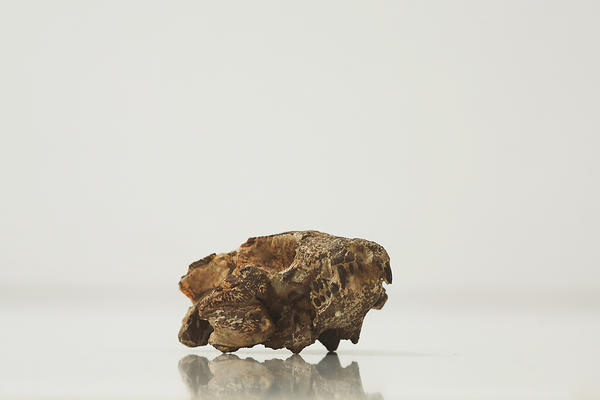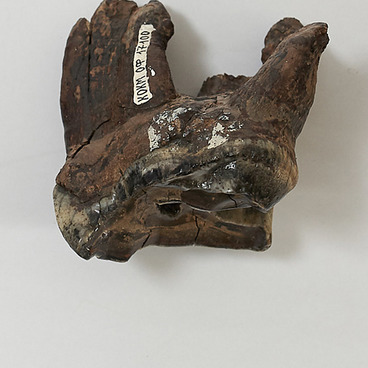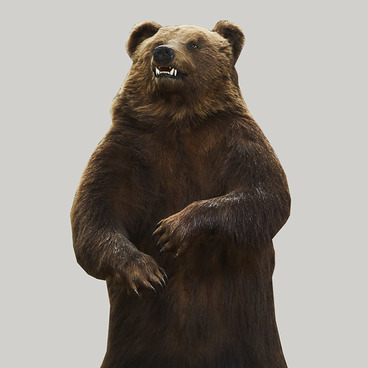The window displays Crocodylia Tagarosuchus Kulemzini Efimov, found as a result of excavations of a ‘dinosaur cemetery’ in the north of Kemerovo Region. Tagarosuchus was named in honor of the Siberian Scythians, the Tagar people. In addition, the name of the ancient animal is associated with the name of Professor Anatoly Kulemzin, who in 1997 was lucky to find the remains of Tagarosuchus near Shestakovo.
Crocodiles living on the Kiy River 130 million years ago were amazingly small in size, reaching only half a meter in length. They had a small, almost square skull, 6 by 4.5 cm in size, and 20 fine sharp teeth indicating that, though small, tagarozuchus was a predator. It was the largest of the crocodilomorphs of its time. It lived mainly on land and moved quite quickly, being able even to gallop.
Due to its small size, it could hunt in the thickets, which large dinosaurs could not afford, extracting food in open areas. Tagarozuchus fed on lizards and small mammals who moved slower and were doomed if they lost their vigilance and failed to hide in burrows or under stones.
On those rare days when tagarosuchus’ hunt ended unsuccessfully, it did not mind carrion, finding dead animals on the shore, or picked up leftovers after a carnivorous dinosaur. It always paid attention to abandoned nests with rotten eggs as well. But, as a rule, tagarozuchus was a successful hunter and extremely rarely remained without lunch.
At the same time, ordinary crocodiles who were abundant in water reservoirs around the world, were not found on the territory of the present Kuznetsk coal basin, even in the early Cretaceous period of the Mesozoic era, when the sun of Siberia was still burning mercilessly, taking short rests between the rainy seasons. Among grasses and trees, carnivorous and herbivorous dinosaurs frolicked and hunted: two-meter-tall, like harmless psittacosaurs, and thirty-meter-tall, like those found in the Shestakovsky Yar. And there were no crocodiles.
We don’t know whether it was the water that did not suit them, or the ground was not warm enough to hatch eggs. But the fact remains that only mini-crocodiles lived in the Siberian open spaces. They also disappeared from the face of the Earth over time, unable to withstand great hunting.
The findings made by the Museum of Local History together with the Paleontological Institute of the Russian Academy of Sciences allowed us to reconstruct the miniature Siberian crocodile and to find out more about the lifestyle of Tagarozuchus.
Crocodiles living on the Kiy River 130 million years ago were amazingly small in size, reaching only half a meter in length. They had a small, almost square skull, 6 by 4.5 cm in size, and 20 fine sharp teeth indicating that, though small, tagarozuchus was a predator. It was the largest of the crocodilomorphs of its time. It lived mainly on land and moved quite quickly, being able even to gallop.
Due to its small size, it could hunt in the thickets, which large dinosaurs could not afford, extracting food in open areas. Tagarozuchus fed on lizards and small mammals who moved slower and were doomed if they lost their vigilance and failed to hide in burrows or under stones.
On those rare days when tagarosuchus’ hunt ended unsuccessfully, it did not mind carrion, finding dead animals on the shore, or picked up leftovers after a carnivorous dinosaur. It always paid attention to abandoned nests with rotten eggs as well. But, as a rule, tagarozuchus was a successful hunter and extremely rarely remained without lunch.
At the same time, ordinary crocodiles who were abundant in water reservoirs around the world, were not found on the territory of the present Kuznetsk coal basin, even in the early Cretaceous period of the Mesozoic era, when the sun of Siberia was still burning mercilessly, taking short rests between the rainy seasons. Among grasses and trees, carnivorous and herbivorous dinosaurs frolicked and hunted: two-meter-tall, like harmless psittacosaurs, and thirty-meter-tall, like those found in the Shestakovsky Yar. And there were no crocodiles.
We don’t know whether it was the water that did not suit them, or the ground was not warm enough to hatch eggs. But the fact remains that only mini-crocodiles lived in the Siberian open spaces. They also disappeared from the face of the Earth over time, unable to withstand great hunting.
The findings made by the Museum of Local History together with the Paleontological Institute of the Russian Academy of Sciences allowed us to reconstruct the miniature Siberian crocodile and to find out more about the lifestyle of Tagarozuchus.



